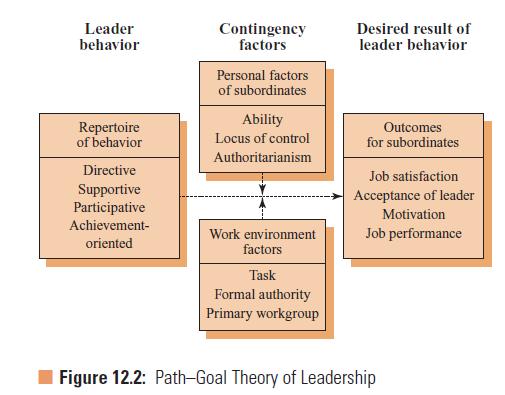The pathgoal theory of leadership describes two sets of contingency factorspersonal factors of subordinates and work environment
Question:
The path–goal theory of leadership describes two sets of contingency factors—personal factors of subordinates and work environment factors. Discuss how these factors affect the choice of leader behavior. Give examples from your work experiences.
House’s Path–Goal Theory of Leadership
Robert J. House developed the path–goal theory of leadership to resolve inconsistencies in previous leadership research. A contingency theory says characteristics of the situation govern the choice of leader behavior. Although path–goal theory and Fiedler’s theory are both contingency theories, they view the contingency relationship differently. An extensive analysis of empirical studies showed partial support for the theory. Reviewers of the research history of path–goal theory noted its complexity and lack of thorough testing. Path–goal theory sees the leader’s role as affecting a subordinate’s motivation to reach desired goals. The leader affects a subordinate’s motivation by using rewards when the subordinate reaches desired goals, being supportive while the subordinate is trying to reach the goals, making intrinsically motivating task assignments, and clearing barriers to goal accomplishment. The theory’s name summarizes what a leader does—clearing subordinates’ paths so they can reach desired goals. A leader’s behavior can enhance a subordinate’s motivation and increase a subordinate’s job satisfaction. Acceptance of the leader by the subordinate should also increase. Path–goal theory proposes four leader behaviors:
Directive: Directive leader behavior focuses on what must be done, when it must be done, and how it must be done. This behavior clarifies performance expectations and the role of each subordinate in the workgroup.
Supportive: Supportive leader behavior includes concern for subordinates as people and the needs they are trying to satisfy. Supportive leaders are open, warm, friendly, and approachable.
Participative: Participative leader behavior includes consultation with subordinates and serious consideration of subordinates’ ideas before making decisions.
Achievement-oriented: Achievement-oriented leader behavior emphasizes excellence in subordinate performance and improvements in performance. An achievement-oriented leader sets high performance goals and shows confidence in people’s abilities to reach those goals.
The four behaviors of path–goal theory have several important qualities. Directive and supportive behavior are the same as initiating structure and consideration. These two behaviors have been a consistent part of leadership research and are basic to the functioning of leaders in organizations. Participative leader behavior emphasizes the decision-making function of leaders. Note that subordinate participation emerges as an important part of decision making.
Achievement-oriented leader behavior is the heart of subordinate motivation. Chapter 8, “Motivation: Cognitive and Behavioral Theories and Techniques,” showed how high and achievable performance goals are part of high work performance. The leader’s expressed confidence also emerges as an important contributor to motivation.
The path–goal theory describes two sets of contingency factors that play important roles in the choice of leader behavior: (1) personal factors of subordinates and (2) work environment factors.
Personal factors are subordinates’ perceptions of their ability, their perceptions of the source of control (locus of control) over what happens to them, and their views about people in authority positions (authoritarianism). Work environment factors include tasks, the nature of the system of authority in the organization, and the primary workgroup.
Figure 12.2 shows the structure of path–goal theory. The four leader behaviors are described as a “repertoire” to emphasize that the leader chooses among the behaviors. The theory does not suggest that leaders should use all behaviors. The choice of behavior is based on the skills and personality of the leader and on the circumstances facing the leader. Those circumstances include contingency factors from the person and from the work environment.
Subordinates whose ability is less than that required by the task are likely to respond positively to directive leader behavior. They welcome clarification of their duties and tasks because their level of ability makes it difficult to complete the task. High-ability subordinates might feel such leader behavior is unnecessary and demeaning, because they already know what to do and do not need the boss telling them how to complete a task.
People can perceive the locus of control of their behavior as either internal or external to them. Subordinates who feel their behavior is responsible for the results they achieve (internal control) are likely to respond positively to participative behavior and less positively to directive behavior. Because they feel in control, they do not want the leader to direct them to task completion. Instead, they like to affect decisions that lead to task accomplishment. Low participative and directive leader behavior work better for subordinates who feel externally controlled.
People high in authoritarianism are strongly status-oriented. They readily accept the direction of people in an authority position and want to please them. People low in authoritarianism are flexible and tend not to defer to authority. People high in authoritarianism accept directive leader behavior, whereas people low in authoritarianism prefer participative behavior.
Step by Step Answer:

Organizational Behavior Integrating Individuals Groups And Organizations
ISBN: 9780415804646
4th Edition
Authors: Joseph E. Champoux





